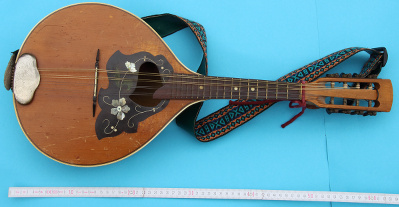
300 dpi JPEG

Hier geht's zur deutschsprachigen Version
Go here to the German version
 300 dpi JPEG |
Mandolin |  Hier geht's zur deutschsprachigen Version Go here to the German version |
The mandolin belongs to the short-necked lutes. It was developed from medieval mandola (mandore) in the
17th century. It's a wire strung instrument with four courses (pairs of strings, strings unison) those are plucked with a plectrum.
The fingerboard is fretted that should simplify the playing. Unfortunately these frets strongly reduce possibility to play microtones.
Besides, spaces between frets are designed for standard tuning of mandolin strings. If single courses are tuned in difference
to their standard tuning the instrument isn't fretting right. Usually useful tunings can only be realized if each course is maximally
tuned ±1 whole tone in difference to their standard tuning. Tuning strings higher entails a risk (tear of the strings, damaging of the instrument). Don't do this, if you don't know what you are doing!
Playing chordal two or three or all four courses are plucked. Playing monophonic only one course is plucked or the instrument is played with
its characteristic tremolo. To realize this tremolo the plectrum is moved back and fourth across the two strings of one course. This tremolo
is not very useful for chordal playing.
| Standard tuning of mandolin corresponds with that of violin: |  |
To play medieval music this tuning can only be used for monophonic playing. If only accompaniment is required two other tunings are used in dependence on the available melodic instruments:
| accompaniment-g-tuning |  |
accompaniment-a-tuning |  |
It's very easy to handle these tunings. One course is tuned up to tuning pitch. After that only one perfect fifth and one
perfect octave have to be tuned. Perfect fourth between the two middle courses results automatically. Full barré fingerings are
normally played.
Following tuning is very useful to play medieval music. This tuning enables both monophonic and two-part soloistic playing and
accompaniment:
| drone-a-tuning |  |
Handling of this tuning is a little bit difficult. A short explanation is following:
At the beginning one course is tuned up to tuning pitch. Today a tuning fork with tuning pitch
a1 = 440 Hz is normally used. Lowest course is tuned onto the octave below, therefore
onto tone a0, to this tuning pitch. Then second lowest course is tuned onto the perfect fifth
above, therefore onto tone e1, to the lowest course. After that second highest course is fingered
on second fret and it's tuned onto the octave above, therefore onto tone a1, to lowest course.
At least highest course is tuned onto the perfect fifth above, therefore onto tone d2, to
second highest course that's not fingered (= tone g1). To check this tuning the two high courses are
played with a half barré fingering on second fret and all four courses are plucked. If any beatings don't appear drone-A-tuning is ready.
ATTENTION PLEASE! The minor third between the two middle courses may sound a little bit strange. This is caused by Pythagorean
temperament that's normally used for interpretation of medieval music and that's based on here.
Using this tuning often the melody is only played on the two high courses whereas the two low courses aren't fingered and only plucked as
drones in addition to the melody.
Recorder |
Top |
Main page |
© Sönke Kraft, Hannover 2002 last update: 25.10.2015 |